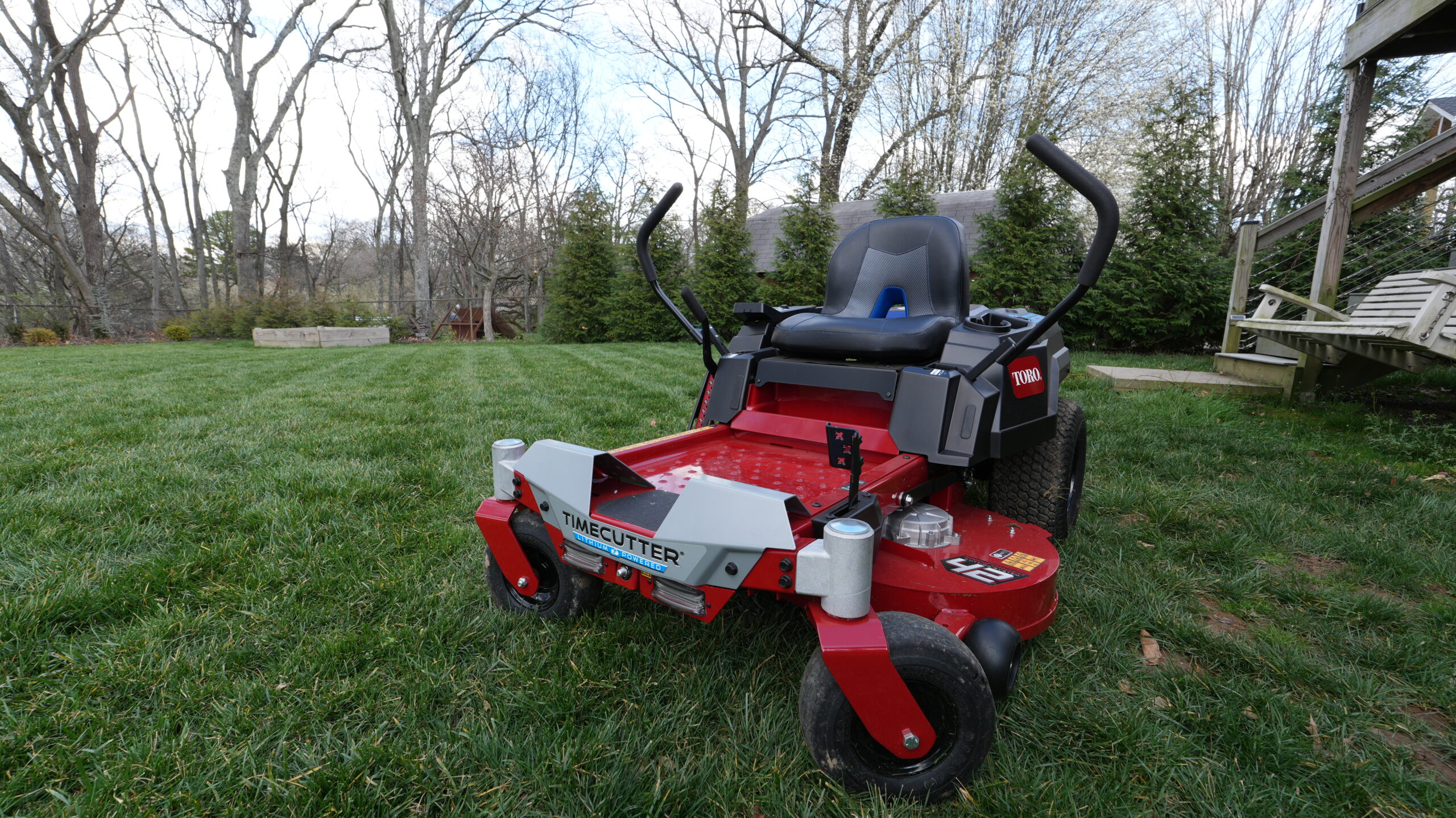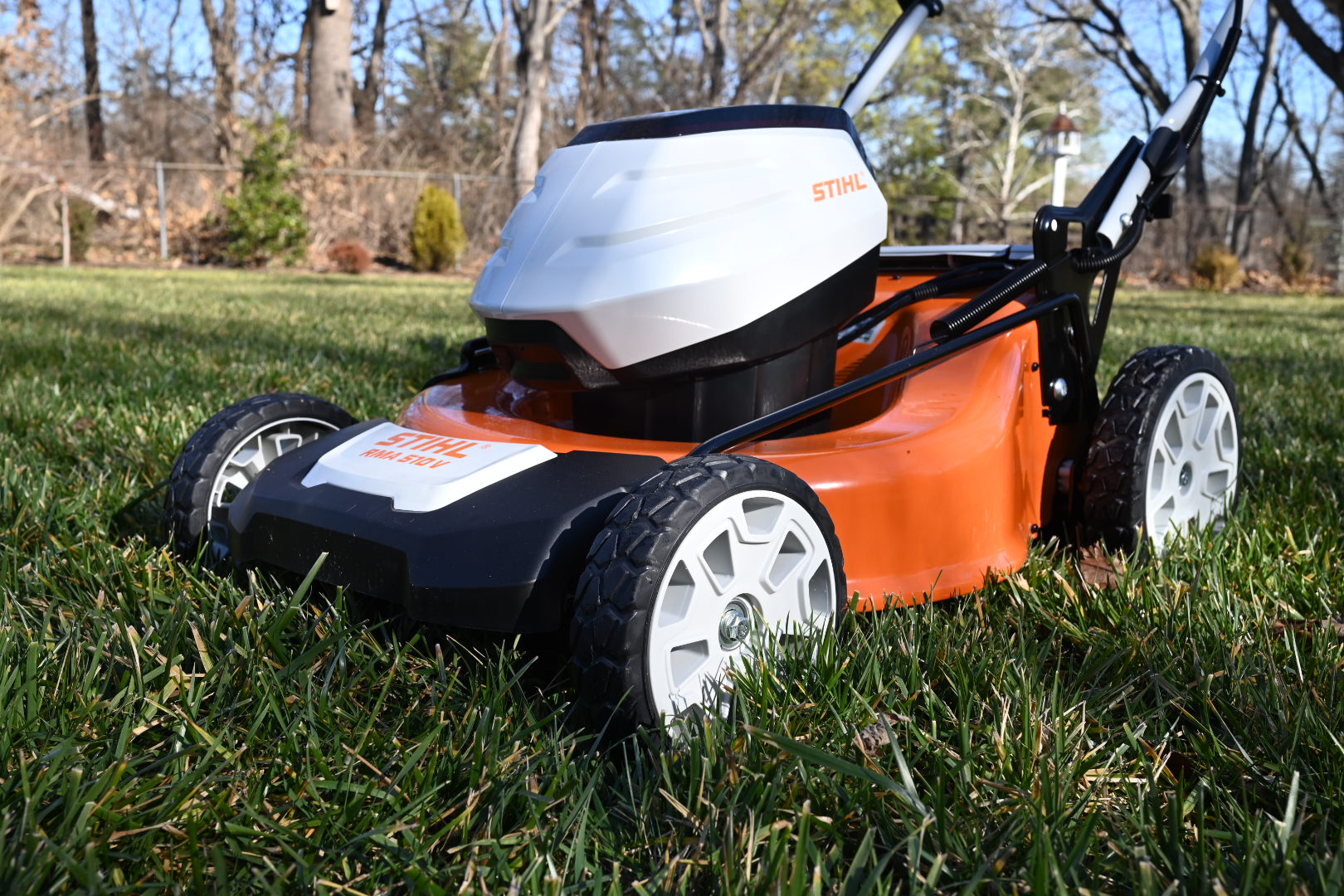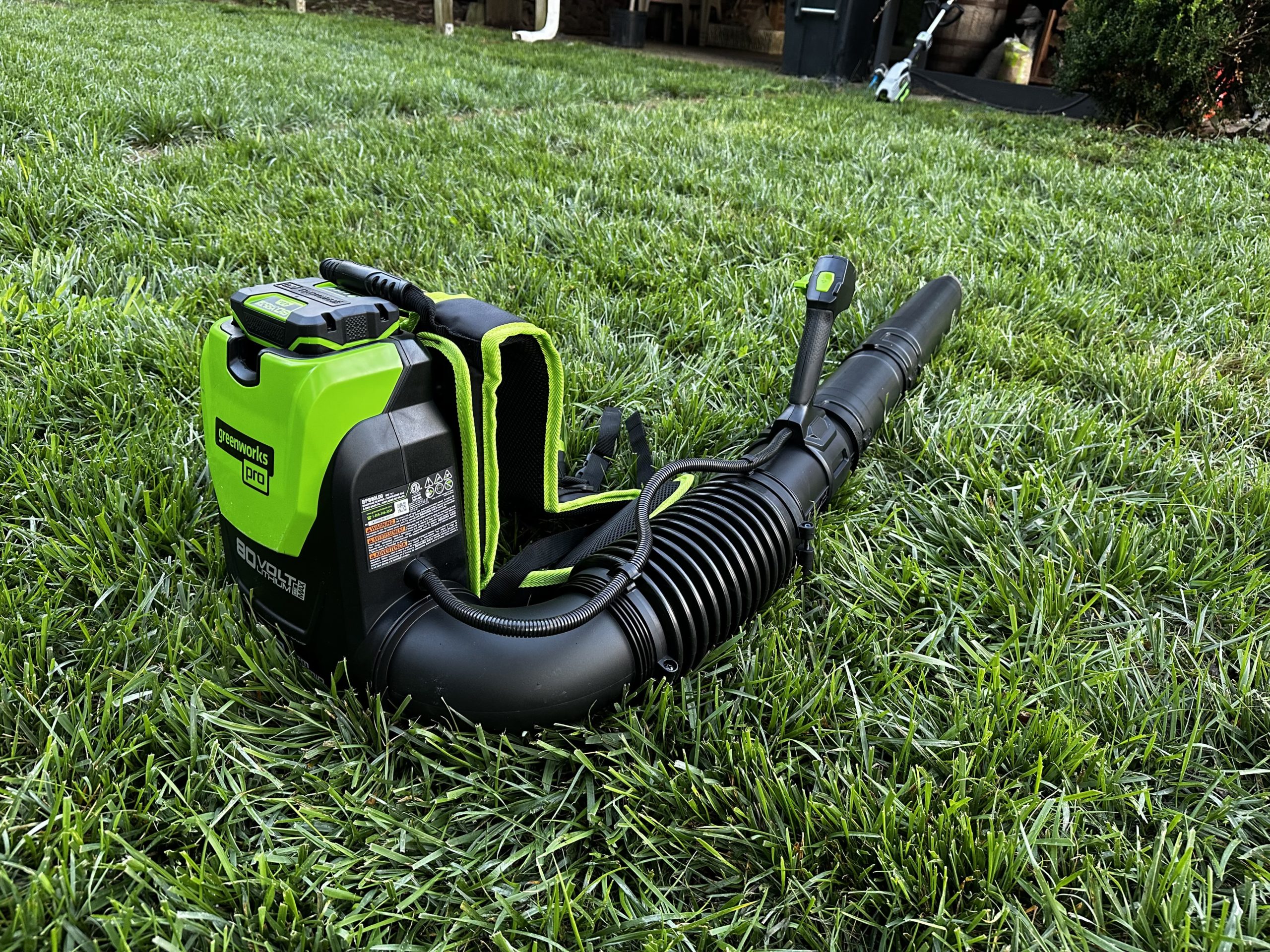EGO vs Ryobi leaf blowers is a new beef. These are the two top battery-powered leaf blower brands on the market and they’re facing off. I like the EGO blower better because it feels sturdier and is more powerful.
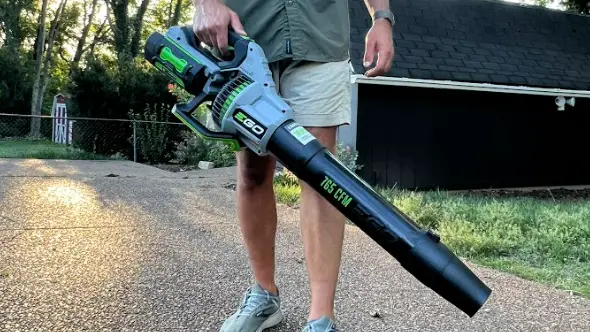
Rocky vs. Ivan Drago. They’re both beasts. They’ve both been working their whole life for this.
And we are officiating. It got messy and involved an unmanned office chair spinning out of control.
Luckily, we got our hands on the EGO 765 CFM leaf blower and the Ryobi 40V 730 CFM Brushless Whisper Series blower. Here is what we tested on both:
And there was only one winner. Let’s dive right in.
***SPOILER***: We give the advantage to the EGO 765 CFM blower because it’s more powerful with a longer run-time. You can grab it on Amazon for a great price.
EGO 56V vs Ryobi 40V Whisper Blower: A Breakdown
Let me tell you – this wasn’t an easy comparison. These are the two premier battery powered leaf blowers on the market and you honestly can’t go wrong with either.
But c’mon – one of them has to be better, right?
Let’s find out.
User Experience: EGO compared to Ryobi blowers
Using both the EGO and Ryobi blowers, the first question we got was about sound. One of the main benefits of using battery powered blowers is that they don’t have nearly the same noise levels as gas powered blowers.
Sound and noise from EGO and Ryobi blowers
EGO had a lower-pitched whirring sound whereas Ryobi had a much higher frequency screaming noise. The Ryobi 40V blower is a part of the Whisper series of equipment from Ryobi. While it was definitely a lower decibel level than the EGO, it had an unpleasant high-pitched noise that wasn’t much better honestly.
Weight
From a weight perspective, the EGO comes in at 9.4lbs whereas the Ryobi is a little lighter right at 9lbs. Weight is important when using a blower because without a strap, you’re on the hook for holding these during the entire duration of your blowing experience. If you’re going to be out there for a decent amount of time, then you need to make sure you have a lightweight blower to get the job done. Fortunately, these are both relatively lightweight when compared to a gas blower but slightly heavier than many other electric blowers.

Controlling these two blowers is easy
From a control perspective, I’m looking for something that gives me total control over the speed of the blower that is easy to adjust and access on the fly.
Both the EGO and Ryobi blowers have a variable speed control trigger, meaning you can control how much power you’ve got at any moment in time.
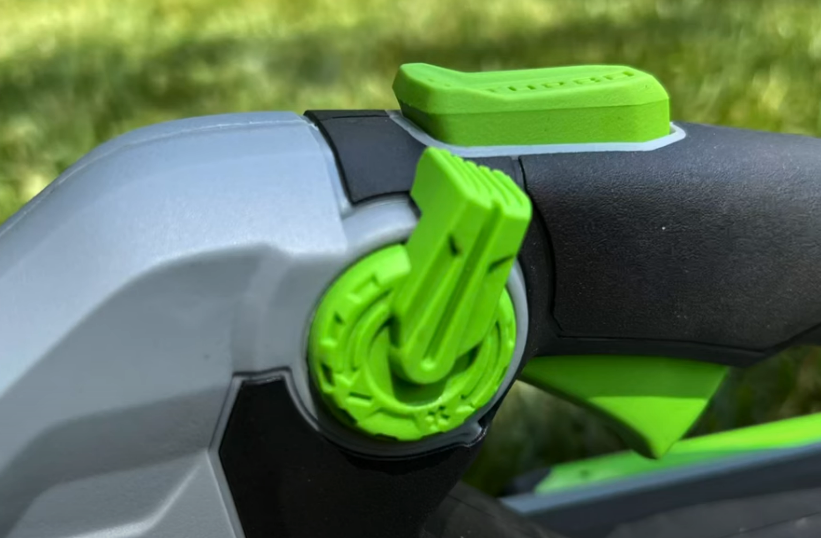
Both have a cruise control function that can be adjusted with the thumb with the same hand that controls the variable speed trigger (for right-handers only).
Both the Ryobi and EGO blowers have a turbo button, which takes it from their base level of CFMs up to their maximum (more on that later).
Overall, both offer similar controls and come in at almost the exact same weight. If you’re looking to pick one based on user experience, the differentiating factor between the EGO and Ryobi blowers is the sound. One is louder, one has a funnier noise – it comes down to preference. Listen to both on our video to see which one you prefer.
Battery Life – EGO vs Ryobi blowers
Both the EGO and Ryobi both have lithium ion batteries, meaning they put out the same amount of power regardless of whether they have 5% battery life or 95%.
Ryobi’s 40V battery that comes on the whisper series brushless blower is a 4 Ah 40V battery. You can use other 40V batteries from them with higher or lower Ah, but the 4.0 comes standard. The higher the Ah, the longer the battery will run.
The EGO 765 CFM blower comes with a 5 Ah battery but can handle more as well.
Run time comparison of EGO and Ryobi batteries
Here at The Lawn Review we like to get a little wild. So our first run-time test is going to compare the two blowers with their triggers and turbo buttons zip-tied down.

The results looked like this:
- EGO turbo button run time: 15 minutes
- Ryobi turbo button run time: 12 minutes
Pretty close but 3 minutes matter when you’re standing out in the sun!
Next was the highest speed without the turbo button. Again, we used zip ties and got these results:
- EGO full speed blower run time: 25 minutes
- Ryobi full speed blower run time: 16 minutes
The last speed test for us was the low speed test. We zip tied these ones on the lowest setting and well….it took a while. Here were the results:
- EGO low speed blower run time: 157 minutes
- Ryobi low speed blower run time: 90 minutes
While the majority of the run time differences come down to the difference in Ah between the two, I didn’t expect them to be that stark. The EGO definitely wins this category.
The last battery test was how long it takes to get to a full recharge using the EGO and Ryobi battery chargers.
Here’s how long it took:
- Ryobi 40V battery charge time: 70 minutes
- EGO 56V battery charge time: 53 minutes
Ryobi pulls this one out with a faster battery run time at under an hour.
The EGO blower is more powerful than Ryobi
What may be the most important category yet, things start to get really wild when we compare power. I’m talking out-of-control-spinning-office-chair-wild.
But first, a quick intro into how power is measured in blowers. Both the EGO and Ryobi blower use brushless motors, which means they use magnets to help transfer electrons instead of brushes. Brushes were prone to become fried due to the constant friction inside of the motor, leading to early deaths and overheating.
CFM vs MPH explained
CFM and MPH are the two most important things in assessing power for the blower. CFMs dictate the amount of volume that comes out of the blower whereas MPH refers to the speed at which the air leaves. If you recall from the beginning of this post, high CFMs typically mean a big burst of air. High MPH means the air is moving really quickly. They often have an inverse relationship where one is high and the other is low.
In both of these blowers, the CFMs and MPH are super high. The EGO has 765 CFMs when on full turbo at 200 MPH. That’s crazy. The Ryobi has 730 CFMs at 190 MPH. These are both insane when on turbo mode.
To test this, we blew a pile of dirt off of a plywood to compare their relative power.

The EGO blew away (pun intended) the Ryobi in this test.
To take it up a notch, we decided to use the scientific and professional face test. Yes, we put Tyler’s face in front of the blowers and had him tell us which was the most powerful. The results were clear:

The EGO was more powerful – much like sticking your head out of a plane, whereas the Ryobi was like sticking it out of a fast moving car. Neither felt good.
Next up was the spinning chair fiasco. Nobody sustained serious injuries during this test. But we attached both blowers to the arms of a spinning office chair and turned them on to see which one would win with both blowing at the same time.

It was a hard cycle to stop. But the EGO won.
The EGO is definitely the more powerful of the two.
Price and Warranty: EGO vs Ryobi blower
The warranties on both the EGO and Ryobi are identical – a 5 year tool warranty and a 3 year battery warranty. They are great and this gives me a lot of comfort as an owner of both.
The Ryobi comes in at around $300 including the blower and two 4 Ah batteries. You can grab it from your local Home Depot, where I’ve seen it for the best price.
The EGO 56V blower will cost about $320 and come with the single 5 Ah battery. It can be purchased at Lowe’s or on Amazon with the battery for a great price.
So which is better, EGO or Ryobi blower?
Let me start by saying that I own both of these so I am trying to be as unbiased as humanly possible. The Ryobi is probably the better deal, but the performance of the EGO is worth $20 to me.
The EGO is slightly heavier but much more powerful and has longer lasting batteries. With the turbo button engaged, it is unrivaled in the handheld electric blower space.
Both are great – but if you’d like to check out the EGO 765 blower, check it out on Amazon. If you’re looking for something a little lighter, we wrote a great post comparing the 765 CFM blower to the 650 blower.
Why we review lawn tools
The reason we started this website in the first place was because we had so much trouble trying to find reasonable, understandable, honest reviews for lawn equipment. And it’s not cheap! After hours and hours of research, trying products and returning them, and messing up our yards – we started this site.
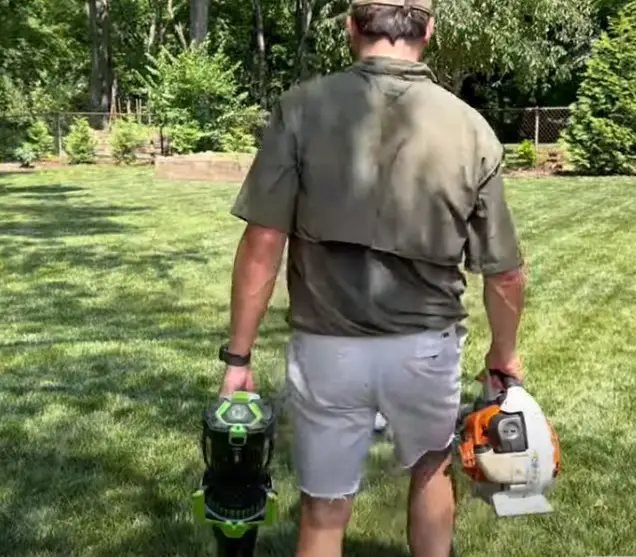
As people who had to learn the hard way, we want you to know exactly what you are signing up for before you purchase a piece of equipment. That’s why we are committed to providing honest, easy-to-understand reviews that mean something.
What to look for in an electric blower
Cordless blowers come in a bunch of shapes and sizes but there are three basic things you need to understand:
CFMs on blowers
Cubic feet per minute. This is a measure of air output on the blower. Higher CFM = more power, but not necessarily more miles per hour. High CFM with a wide nozzle = lower MPH. High CFM with a narrow nozzle = high miles per hour. Ideally, you want both a high CFM with a narrow to medium nozzle for most residential jobs.
Usability
What is the point of having a blower if it is hard to use? Have to get one that is lightweight, easy to start, and has some functions that make your life easier. One thing I look for here is how the weight is distributed. I also look for things like variable speed control, sound, and how easy it is to reach or change controls like cruise control.
Motor type
Brushless motors reign supreme. Brushless motors are cooler running motors with more torque, a longer run-time, and last many more years. These are a no brainer when picking a blower.
These are three technical things you need to pay attention to when looking through the specifications.

